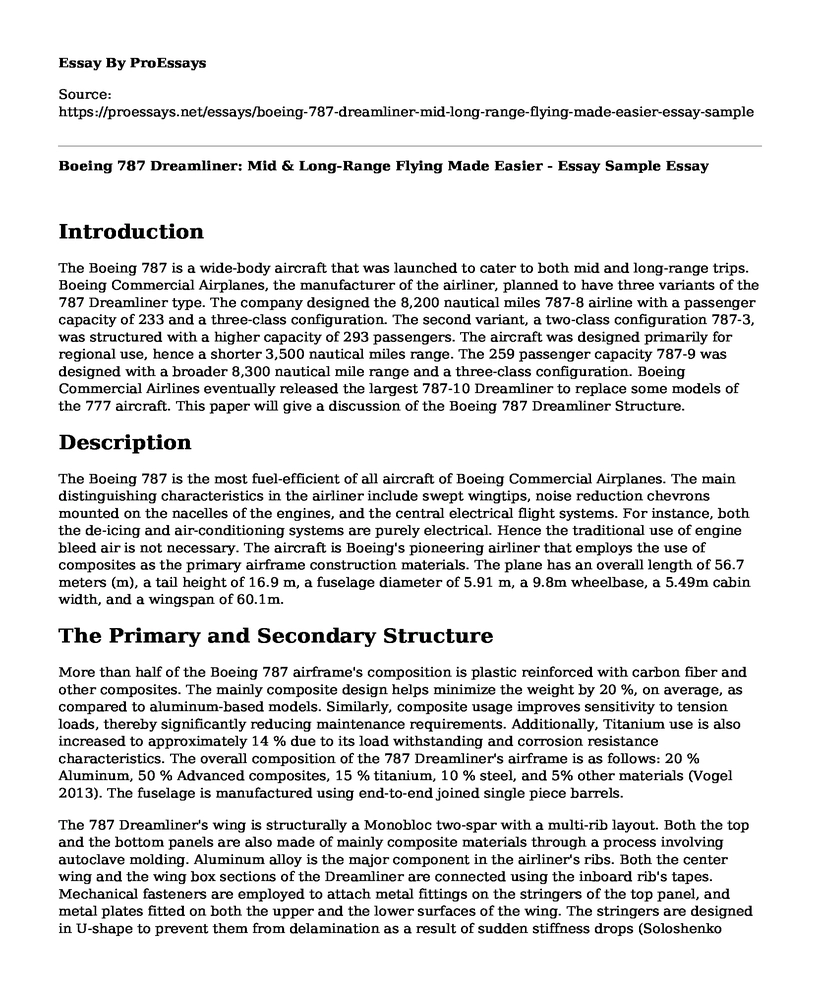Introduction
The Boeing 787 is a wide-body aircraft that was launched to cater to both mid and long-range trips. Boeing Commercial Airplanes, the manufacturer of the airliner, planned to have three variants of the 787 Dreamliner type. The company designed the 8,200 nautical miles 787-8 airline with a passenger capacity of 233 and a three-class configuration. The second variant, a two-class configuration 787-3, was structured with a higher capacity of 293 passengers. The aircraft was designed primarily for regional use, hence a shorter 3,500 nautical miles range. The 259 passenger capacity 787-9 was designed with a broader 8,300 nautical mile range and a three-class configuration. Boeing Commercial Airlines eventually released the largest 787-10 Dreamliner to replace some models of the 777 aircraft. This paper will give a discussion of the Boeing 787 Dreamliner Structure.
Description
The Boeing 787 is the most fuel-efficient of all aircraft of Boeing Commercial Airplanes. The main distinguishing characteristics in the airliner include swept wingtips, noise reduction chevrons mounted on the nacelles of the engines, and the central electrical flight systems. For instance, both the de-icing and air-conditioning systems are purely electrical. Hence the traditional use of engine bleed air is not necessary. The aircraft is Boeing's pioneering airliner that employs the use of composites as the primary airframe construction materials. The plane has an overall length of 56.7 meters (m), a tail height of 16.9 m, a fuselage diameter of 5.91 m, a 9.8m wheelbase, a 5.49m cabin width, and a wingspan of 60.1m.
The Primary and Secondary Structure
More than half of the Boeing 787 airframe's composition is plastic reinforced with carbon fiber and other composites. The mainly composite design helps minimize the weight by 20 %, on average, as compared to aluminum-based models. Similarly, composite usage improves sensitivity to tension loads, thereby significantly reducing maintenance requirements. Additionally, Titanium use is also increased to approximately 14 % due to its load withstanding and corrosion resistance characteristics. The overall composition of the 787 Dreamliner's airframe is as follows: 20 % Aluminum, 50 % Advanced composites, 15 % titanium, 10 % steel, and 5% other materials (Vogel 2013). The fuselage is manufactured using end-to-end joined single piece barrels.
The 787 Dreamliner's wing is structurally a Monobloc two-spar with a multi-rib layout. Both the top and the bottom panels are also made of mainly composite materials through a process involving autoclave molding. Aluminum alloy is the major component in the airliner's ribs. Both the center wing and the wing box sections of the Dreamliner are connected using the inboard rib's tapes. Mechanical fasteners are employed to attach metal fittings on the stringers of the top panel, and metal plates fitted on both the upper and the lower surfaces of the wing. The stringers are designed in U-shape to prevent them from delamination as a result of sudden stiffness drops (Soloshenko 2014).
Assembly
The Boeing 787 Dreamliner is assembled in four positions. In the first position, the aft fuselage, the front, and the middle sections are joined together using fasteners. The wings are then attached, followed by the horizontal stabilizer, which has the tail cone. The assembly of the first position ends with the fitting of the tail fin. The second position begins with the installation of both the landing gear and the engines. At this point, the half-assembled aircraft is towed while rolling on its wheels to stage three, where systems that determine the particular 787 variant specifications are installed. The assembly of the 787 Dreamliner ends with the completion of production testing, painting, and the beginning of flight tests (Vogel 2013).
Flight Controls
The Boeing 787 Dreamliner uses the fly-by-wire control systems as opposed to the traditional mechanical control system. The pilot's control system is based on that of the 777 type. The aircraft has a standard Core Network that uses computing servers and networks. The flow of onboard data is managed using different third party applications, which help in the improvement of the efficiency of the airline. The management of data between the built-in systems of the 787 Dreamliner is achieved using The Common Data Network (CDN), manufactured by Rockwell Collins. This system is composed of a fiber optic and copper network that is bidirectional. The CDN employs Ethernet technology and is significantly effective in aircraft weight reduction, higher data rates, and reliable connectivity (Vogel 2013).
Conclusion
The structure and the wing design of the 787 Dreamliner are highly beneficial in both speed and fuel efficiency. The composite material, which constitutes more than half of the aircraft's structure, is lightweight. The 787 airline has a large single-piece carbon composite based barrel sections which help eliminate approximately 1500 sheets of aluminum and almost 50,000 fasteners in each part of the aircraft. Consequently, the Boeing 787 Dreamliner is not only lighter but also significantly efficient aerodynamically.
References
Soloshenko, V. (2014, September 12). Conceptual design of civil airplane composite wingbox structures. International Council of the Aeronautical Sciences. https://www.icas.org/ICAS_ARCHIVE/ICAS2014/data/papers/2014_0701_paper.pdf
Vogel, Gib. (2013). Flying the Boeing 787. Crowood.
Cite this page
Boeing 787 Dreamliner: Mid & Long-Range Flying Made Easier - Essay Sample. (2023, May 05). Retrieved from https://proessays.net/essays/boeing-787-dreamliner-mid-long-range-flying-made-easier-essay-sample
If you are the original author of this essay and no longer wish to have it published on the ProEssays website, please click below to request its removal:
- Jetblue Airline SWOT Analysis Paper Example
- Airline Industry Case Study Issues
- Essay Sample on US Air Transport Industry: Critical Element in Economy
- Safety in Aviation: Reducing Catastrophic Accidents - Essay Sample
- Company Goals: Roadmap for Successful Business Management.
- Colon: Digestive System's Last Resort for Waste Removal
- The Greatest Lufthansa Robbery - Essay Sample







